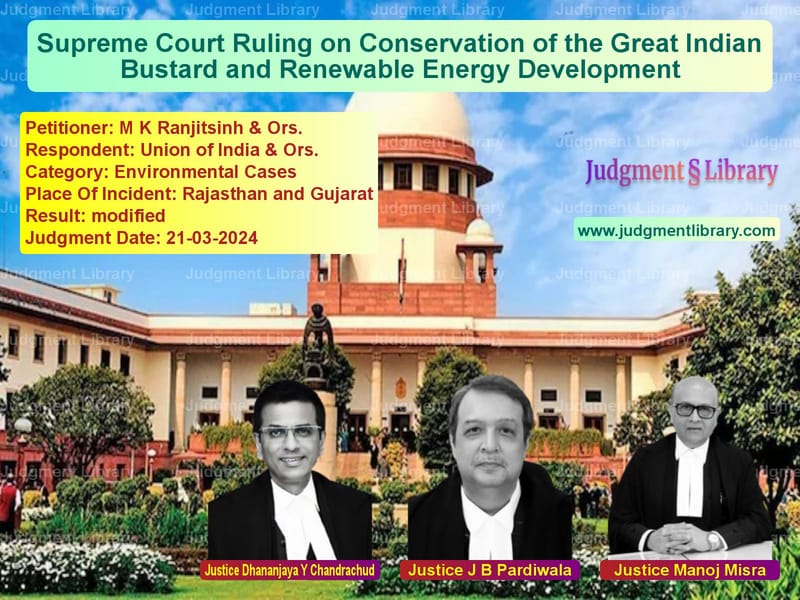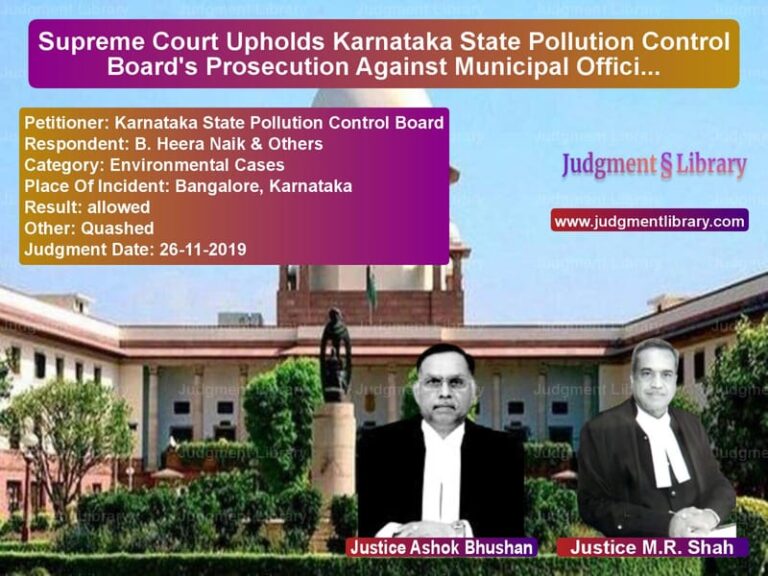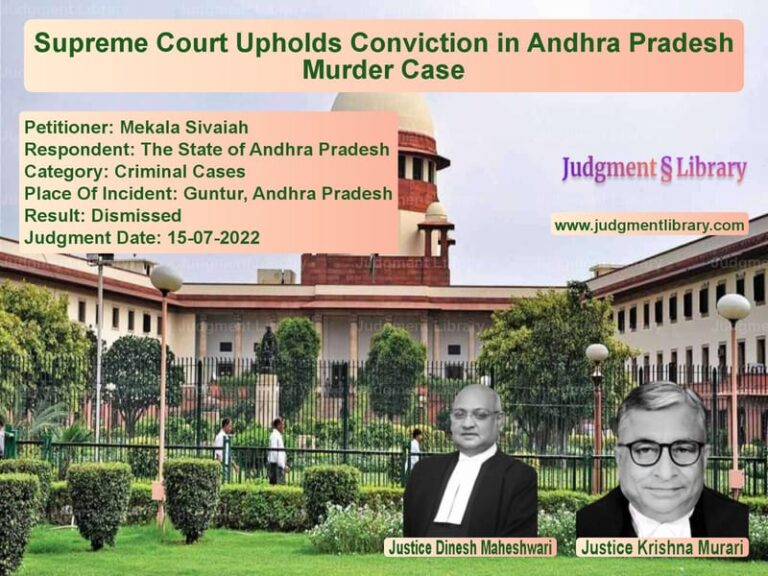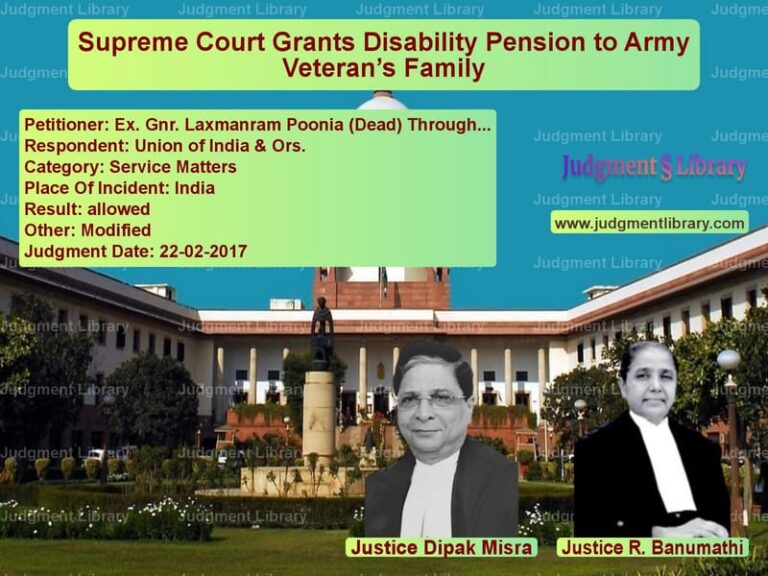Supreme Court Ruling on Conservation of the Great Indian Bustard and Renewable Energy Development
The Supreme Court of India recently delivered a crucial judgment in the case of M K Ranjitsinh & Ors. vs. Union of India & Ors., addressing the conservation of the Great Indian Bustard (GIB) and the challenges posed by renewable energy projects. The Court balanced the need to protect the critically endangered bird species with India’s commitments to renewable energy development under international climate agreements.
Background of the Case
The case originated from a writ petition filed under Article 32 of the Indian Constitution, seeking urgent conservation measures for the Great Indian Bustard and the Lesser Florican. The petitioners highlighted that these species were on the verge of extinction due to habitat destruction, predation, and infrastructure development, particularly high-voltage overhead transmission lines.
In response to the petition, the Supreme Court had earlier directed:
- The conversion of existing high-voltage power lines into underground cables in critical habitats.
- The installation of bird diverters on overhead transmission lines to reduce bird mortality.
- A prohibition on new power projects in designated critical habitats.
Key Legal Issues
- Whether the installation of renewable energy projects in GIB habitats conflicted with wildlife conservation laws.
- Whether the Court’s previous order on undergrounding power lines was practically feasible.
- How to balance conservation efforts with India’s obligations under the Paris Climate Agreement.
Arguments by the Petitioners (Conservationists)
The petitioners, led by environmentalists and wildlife conservationists, argued that:
- The GIB population had fallen to fewer than 150 individuals, making it one of the world’s most critically endangered species.
- Overhead power transmission lines posed a major threat, causing frequent bird collisions.
- The government must implement large-scale habitat conservation measures, including banning new infrastructure projects in critical habitats.
- The installation of predator-proof enclosures and breeding centers was essential to preserving the species.
Arguments by the Respondents (Union of India & Energy Ministries)
The respondents, represented by the Ministry of Environment, Forests and Climate Change and the Ministry of New and Renewable Energy, argued that:
- The previous court order to underground all power lines across 99,000 square kilometers was impractical and would significantly impact India’s renewable energy goals.
- India had international commitments under the Paris Climate Agreement and the United Nations Framework Convention on Climate Change (UNFCCC) to transition towards renewable energy.
- High-voltage underground transmission lines were technically infeasible and would increase project costs significantly.
- The government had already implemented measures such as the Habitat Improvement and Conservation Breeding of Great Indian Bustard initiative.
Supreme Court’s Observations and Judgment
1. The Conservation of the Great Indian Bustard is a National Priority
The Court reaffirmed that the conservation of the GIB was a matter of national importance, noting:
“The Great Indian Bustard is a critically endangered species facing extinction. Urgent conservation efforts are needed to prevent its functional extinction within a few decades.”
2. Renewable Energy is Essential for Combating Climate Change
The Court also recognized the importance of India’s renewable energy commitments:
“India’s commitment to transitioning towards renewable energy is a global responsibility under international climate treaties. It must be balanced with environmental conservation efforts.”
3. Modification of the April 19, 2021, Judgment
The Supreme Court modified its earlier ruling by:
- Allowing overhead transmission lines in certain areas where undergrounding was technically unfeasible.
- Mandating the installation of high-quality bird diverters in all priority and potential habitats.
- Setting up an Expert Committee to assess the feasibility of underground power lines in specific regions.
- Directing the Union Government to intensify conservation efforts, including captive breeding and habitat protection.
4. Expert Committee Formation
The Court appointed an Expert Committee comprising wildlife conservationists, power sector specialists, and government representatives to:
- Evaluate the feasibility of undergrounding transmission lines in GIB habitats.
- Develop a conservation action plan balancing wildlife protection and renewable energy development.
- Oversee the installation of bird diverters and ensure compliance with best practices.
Implications of the Judgment
This ruling has significant environmental and economic implications:
- Stronger conservation measures: Reinforces protection for critically endangered species.
- Support for renewable energy: Ensures India continues expanding solar and wind projects.
- Improved environmental governance: Establishes expert oversight for infrastructure projects.
- Policy clarity: Provides guidelines for balancing conservation with energy needs.
The judgment highlights the Supreme Court’s role in balancing environmental protection with India’s developmental aspirations. It sets a precedent for integrating climate commitments with biodiversity conservation.
Petitioner Name: M K Ranjitsinh & Ors..Respondent Name: Union of India & Ors..Judgment By: Justice Dhananjaya Y Chandrachud, Justice J B Pardiwala, Justice Manoj Misra.Place Of Incident: Rajasthan and Gujarat.Judgment Date: 21-03-2024.
Don’t miss out on the full details! Download the complete judgment in PDF format below and gain valuable insights instantly!
Download Judgment: m-k-ranjitsinh-&-ors-vs-union-of-india-&-ors-supreme-court-of-india-judgment-dated-21-03-2024.pdf
Directly Download Judgment: Directly download this Judgment
See all petitions in Environmental Cases
See all petitions in Judgment by Dhananjaya Y Chandrachud
See all petitions in Judgment by J.B. Pardiwala
See all petitions in Judgment by Manoj Misra
See all petitions in Modified
See all petitions in supreme court of India judgments March 2024
See all petitions in 2024 judgments
See all posts in Environmental Cases Category
See all allowed petitions in Environmental Cases Category
See all Dismissed petitions in Environmental Cases Category
See all partially allowed petitions in Environmental Cases Category







